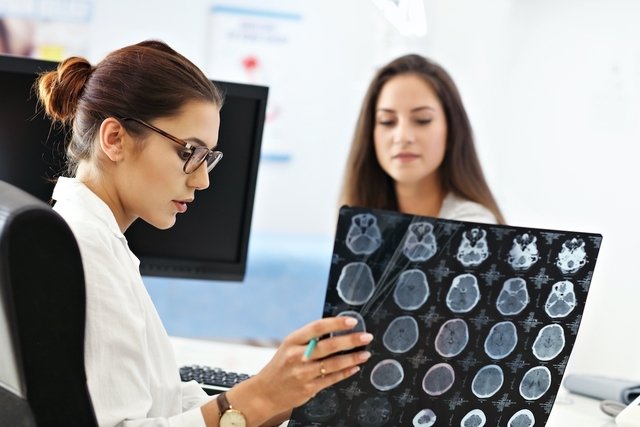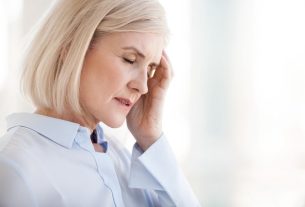Stroke (cerebrovascular accident) can be caused by the accumulation of fat inside the vessels, smoking, high blood pressure, strong blows to the head, aneurysm, cardiac changes or be a consequence of the use of anticoagulants, for example.
A stroke can be ischemic, when there is an obstruction of the blood vessel, interfering with the flow of blood to the brain and giving rise to areas without oxygen, or hemorrhagic when there is bleeding inside the brain due to rupture of the vessels.
As a consequence of a stroke, it is possible for sequelae to appear that vary according to the severity of the brain injury, such as weakness on one side of the body or difficulty speaking, for example, and it is essential that the person is monitored by a doctor. See more about the consequences of stroke.

13 main causes of stroke
The main causes of stroke are:
1. Poor diet
Poor diet can increase the risk of stroke, and is normally related to the consumption of foods rich in fats, fried foods, salt, carbohydrates and sugars.
This is because these foods favor the accumulation of fat within the vessels and contribute to reducing the elasticity of the body’s blood vessels, including the brain.
When this happens, blood cannot pass through and cells in the affected region begin to die due to lack of oxygen, resulting in ischemic stroke.
What to do: It is recommended to adopt healthier lifestyle habits, such as having a more balanced diet, rich in vegetables, fruits and lean meats, and practicing physical activity regularly, at least 30 minutes a day. Check out more tips to reduce the risk of stroke.
Don’t ignore your symptoms!
2. High blood pressure
Very high pressure can rupture some of the brain’s vessels, causing a hemorrhagic stroke. Hemorrhagic stroke due to hypertension is more common in people who have very high blood pressure spikes due to lack of treatment.
What to do: It is essential that treatment for high blood pressure is carried out according to the doctor’s instructions, as this makes it possible to control blood pressure levels, avoid peaks and, thus, prevent stroke. See how high blood pressure is treated.
3. High cholesterol
Increased levels of cholesterol and triglycerides favor the formation of fatty plaques in vessels, as well as the development of inflammation in blood vessels and heart disease, increasing the risk of ischemic stroke.
What to do: It is important that the cardiologist is consulted so that a general assessment of the state of health can be carried out and, thus, the most appropriate treatment can be initiated according to the condition that the person presents, and the use of specific medications and improvement of habits may be recommended. life and food.
4. Diabetes
Diabetes is a risk factor for stroke as it can cause changes in blood vessels anywhere in the body, and when it affects the blood vessels in the brain it can cause ischemic or hemorrhagic stroke.
Additionally, diabetes can also increase the stiffness of blood vessels, as well as increase inflammation in the vessels, which contributes to the development of atherosclerosis. Understand what atherosclerosis is and its main symptoms.
What to do: the treatment indicated by the endocrinologist must be carried out with the use of oral and/or injectable antidiabetics, such as insulin or semaglutide, for example, with the aim of reducing and normalizing blood sugar levels, and avoiding long-term complications of diabetes , such as stroke.
5. Smoking habit
Smoking is a well-established risk factor in the medical community for both ischemic and hemorrhagic strokes.
This is because the habit of smoking increases blood pressure, reduces blood oxygenation, increases platelet aggregation and the risk of blood clot formation, in addition to causing damage to blood vessels, reducing good cholesterol (HDL) and favoring the development of atherosclerosis.
What to do: It is important to stop smoking to reduce the risk of stroke. If a person has difficulty stopping the use of cigarettes, they should consult their general practitioner who can recommend measures to stop smoking or medication, such as bupropion or varenicline. See the main remedies to stop smoking.
6. Obesity
Obesity or overweight is also a risk factor for stroke as it can contribute to the development of heart disease, high blood pressure, high cholesterol or type 2 diabetes.
Furthermore, obesity can cause inflammation in the body, caused by the amount of adipose tissue, in addition to hyperglycemia and insulin resistance that can result in atherosclerosis.
What to do: You must follow a balanced diet guided by a nutritionist and practice physical exercise regularly to increase the calorie deficit, which works. in weight loss.
Furthermore, in some cases, the endocrinologist may recommend the use of medication to help reduce appetite and binge eating, or even bariatric surgery. Find out when bariatric surgery is indicated.
7. Sedentary lifestyle
A sedentary lifestyle is a lifestyle in which physical activity is not practiced, which can result in obesity, diabetes, high cholesterol, high blood pressure or metabolic diseases, increasing the risk of developing stroke.
What to do: You should practice physical exercise regularly, with the WHO recommending at least 150 to 300 minutes of moderate aerobic physical activity per week for adults and around 60 minutes per day for children and adolescents. However, to get out of a sedentary lifestyle, you must set goals and start slowly, such as reducing car use or replacing the elevator with stairs, for example. See how to get out of a sedentary lifestyle.
8. Blow to the head
Cranioencephalic trauma, which can occur in traffic accidents or falls from a great height, for example, is an important cause of stroke, as it can cause bleeding in and around the brain, being a very serious situation that puts life at risk. person’s life.
What to do: In the event of an accident, it is important that the person is quickly referred to the nearest health service so that they can be assessed and the most appropriate treatment can be initiated to avoid complications.
9. Changes in the heart or blood vessels
Some changes in the cardiovascular system, such as dilation of the heart, dysfunction in the functioning of the heart muscle or its valves, the presence of a tumor or calcification, can contribute to the formation of clots, which can reach the brain through the bloodstream and interfere with the flow of blood. blood, causing ischemic stroke.
What to do: Some heart changes do not cause signs or symptoms and, therefore, it is important that routine cardiovascular tests are carried out to assess the health of the heart and check any changes that may exist early. If a change is noticed, the doctor must indicate the most appropriate treatment, which can be done with regular monitoring, use of medication or surgery.
10. Aneurisma cerebral
A cerebral aneurysm corresponds to a weaker point in the vessels within the brain, which can rupture more easily and cause local hemorrhage, giving rise to a hemorrhagic stroke. See more about brain aneurysm.
What to do: This type of change is most commonly discovered accidentally, when CT or MRI exams are performed for other causes. However, an aneurysm can be suspected in the presence of symptoms such as frequent headaches that gradually worsen, seizures, or weakness and tingling in some part of the body, for example.
Therefore, it is important that the doctor is consulted to confirm the diagnosis and begin treatment, which can be done with the use of medication or surgery.
11. Use of illicit drugs
The use of illicit drugs, especially injectable drugs, such as heroin, for example, favors damage and spasms in blood vessels, which can contribute to the formation of clots and, consequently, stroke.
What to do: In these cases, it is recommended to seek help from a specialized drug center so that the detoxification process can be carried out and, thus, contribute to the person’s quality of life and reduce the chances of stroke.
12. Vasculitis
Vasculitis is the inflammation of the blood vessels, including the vessels that reach the brain, which results in a change in blood flow, increasing the risk of stroke due to the reduction in the arrival of oxygen to the region. Learn more about vasculitis.
What to do: It is important that a cardiologist or angiologist is consulted when vasculitis is suspected, as this makes it possible to confirm the diagnosis and initiate the most appropriate treatment, which can be done with the use of corticosteroid medications or surgery.
13. Use of anticoagulants
The indiscriminate use or use of high doses of anticoagulants can increase the risk of bleeding, including within the brain, causing hemorrhagic stroke.
What to do: It is important that the use of anticoagulants is only carried out on medical advice and following their instructions, avoiding excessive doses. It is also important to communicate to the doctor any symptoms or bleeding that occur during the period of use of this medication, as this way the doctor can carry out a general assessment and check the possibility of changing the dose, changing or discontinuing the medication.
Is stroke curable?
There is no cure for a stroke, however, it can be prevented in most cases or, when it happens, it is possible to invest in treatments to improve the condition and rehabilitation to leave fewer consequences.
Furthermore, it is possible for the body to recover largely, or completely, from the symptoms and difficulties that arise with a stroke, which also depends on follow-up with a neurologist and rehabilitation, with:
- Physiotherapywhich helps to recover the motor part and develop movements;
- occupational therapywhich encourages the preparation of strategies to reduce the effects of stroke sequelae in everyday life, adaptations of the environment and utensils, as well as activities to improve reasoning and movements;
- Physical activitycarried out, preferably under the guidance of a physical educator, to strengthen muscles and help with the person’s independence, balance and well-being;
- Nutritionhelps prepare food in the ideal quantity, type and consistency for each person;
- Speech therapyis important in cases of difficulty swallowing food or communicating, helping to adapt to these situations.
In this way, even if the after-effects of the stroke do not diminish or recover quickly, it is possible to improve the quality of life of the person living with this situation.

Sign up for our newsletter and stay up to date with exclusive news
that can transform your routine!
Warning: Undefined array key "title" in /home/storelat/public_html/wp-content/plugins/link-whisper-premium/templates/frontend/related-posts.php on line 12
Warning: Undefined array key "title_tag" in /home/storelat/public_html/wp-content/plugins/link-whisper-premium/templates/frontend/related-posts.php on line 13



